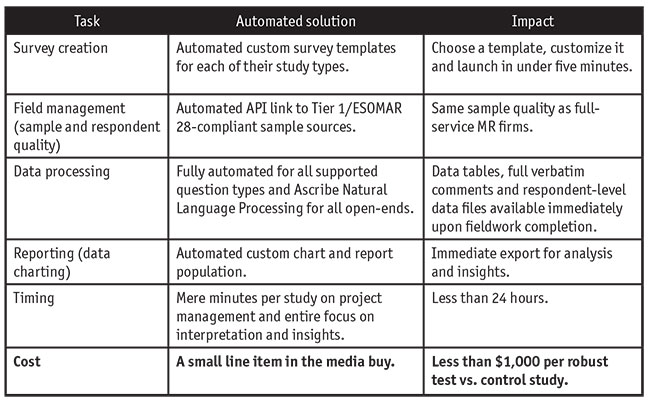SPONSORED CONTENT
How to make automation and DIY your friends
 Chris Hubble
Chris Hubble
CEO, PopResearch
The quote above, from Cath Crowley’s Graffiti Moon, captures the direction of market research (MR) as we embrace do-it-yourself (DIY) tools, automation, metadata and artificial intelligence (AI). Be bold, grow some bolts and embrace the changes machines bring to our processes to create a stronger culture of innovation and insights.
DIY automated tools are becoming as qualified as humans when it comes to logic-based tasks. As machines become smarter and more capable, they will continue to assume these types of roles in market research. Eighty percent of the job I’ve been doing for 30+ years could be automated within the next 15 years. Bring it on – let our collective industry experience get behind machines to make them work smarter and harder for us, especially at dull, repetitive tasks.
While machines may be able to match humans in logic, when it comes to creativity they are woefully inadequate. This is the space we ought to play in as market research consultants.
It doesn’t matter what your role is in the industry, automation is your friend. Maybe you’re a first-time user of market research who can finally afford these services thanks to DIY or a major buyer of market research services whose CFO is patting you on the back for saving the company money. Despite these upsides, there are trade-offs to consider as well. As a first-time user, you’ll likely need professional help to get started. As a major buyer, you’ll likely sweat the additional resources required to pick up the slack of utilizing DIY tools. As a consultant at a supplier, you will need to adapt and assist clients with these sorts of challenges associated with DIY.
The benefits of DIY tools are clear: faster, cheaper and in some cases easier technology. So too are the pitfalls: lack of training and MR knowledge, no visibility into sampling and quality control and sometimes a decrease in efficiency. DIY users must take into account the additional time it will require to construct a study independently, analyze the data and compile accurate insights. At the corporate level, savings in cost and time will be lauded. At the individual level, market research providers must embrace technology, shape it to their needs and anticipate the challenges.
One of the key elements to keep in mind about automated technology is the experiences and opinions of its creators are deeply ingrained in its features and thus in the output we see. So it’s crucial to get involved in creating the next wave of market research technologies – brief the developers, create best practices and design the user interface. Get your hands dirty and make it happen!
For the market research consultant, this means considering all the aspects of your job that can be automated: quality control checks, data integrity, hours of data pulling (with risk of human error), painstaking PowerPoint creation, etc. Your goal should be to make these tasks the purview of automation, leaving you with the complex design, data analysis, interpretation and integration of insights.
For smaller brands and companies using MR services for the first time, automation can provide security and comfort in knowing you have access to industry best practices in survey design, sampling and data integrity. For instance, concept and copy testing have been democratized through automation by companies like PopResearch and Zappi. These companies provide clients with full survey templates, norms and a dashboard of results at a fraction of the cost of traditional, full-service research providers. It is extremely important to audit whichever platform you choose to work with to ensure quality results. Your provider should implement automated sampling (Tier 1/ESOMAR 28-compliant sample sources) and monitor survey response quality control by using tools such as Imperium’s Real Answers. If you are using these tools properly, your only remaining responsibilities should include the customization of your study and the interpretation of results. These are the tasks best-suited for you, as you understand your company’s business goals and challenges better than anyone else.

For enterprise market research users, automation can ease the burden of managing your own research. It can eliminate the need to build out a massive research department to take on project management. Let the machines handle these types of tasks, traditionally managed by Millward Brown, Ipsos or TNS.
For example, one of PopResearch’s enterprise clients wanted to measure the impact of the content they create for their clients. Their media-buying clients frequently requested data to demonstrate efficacy and impact of content but they didn’t want to pay for it. The specific business challenge was that traditional market research tools were not scalable across their 400 advertisers and 3,500 pieces of testable content. A traditional market research provider would also require $1,500 for programming, $1,000 for sample and $1,500 for data processing/coding, totaling $4,000 per ad (unmarked up). That’s a whopping $14 million research budget, not including the cost of labor to manage 3,500 projects. Automation allowed our client to deliver the requested data to their ad sales team and clients at a fraction of the cost, resources and time.
With the help of automation, another enterprise client went from testing ad content only in the United States to executing copy testing globally on all spots. The copy test survey template was automated to ensure global consistency while also allowing the ability to upload creative, customized target audiences and tailor communication goals in under five minutes. Furthermore, fieldwork processes were standardized globally to ensure consistency. Upon fieldwork closing, data tables, verbatim comments and fully charted results were available for download. We were even able to automate comparisons to norms so our client could compare their ads with norms side-by-side in chart format.
The most successful companies will utilize DIY and automated tools alongside more traditional partnerships:
“Automating the process for our content testing has freed up quite literally hundreds of man hours. It has allowed the ad research team at BuzzFeed to take company best practices and innovate and personalize our work to the human intent of each piece of content. We’re able to execute survey setup to finished report with minimal time spent managing the research and all our efforts focused on interpretation of results and integration of research into the ad sales process. It’s hard to imagine automation or technology as advocates but the efficiencies of time and cost automation has provided has made our internal partners at BuzzFeed advocates for the work we do.” – Margo Arton, senior director, ad effectiveness, BuzzFeed.
For several PopResearch clients, quantitative research has historically been viewed as a costly and tedious process. However, automated tools have completely changed this perception. One of our clients said that automated products like PopResearch have saved them significant time and allowed their teams to focus on what really matters to clients: the success of their advertising strategy. They receive results so quickly that they can apply them to upcoming campaigns almost immediately. By using the proper automated tools, your company could save time, money and manpower, allowing your people to focus on client needs.
Throughout history, technological advancements have ignited fear. The battle of “man versus machine” dates back centuries, as does the question, “Are they taking our jobs or merely easing our workloads?”
While automation has the ability to make our lives easier, it certainly has its dangers. The desire for cost reduction may lead to the use of automated tools for tasks they are not yet suited for. Large investments in tools whose life cycles will be short given the pace of change is probable as well. There is also the potential of using automation to repeat well-trodden industry mistakes. I have seen several industry professionals demonstrate this in their cringe-worthy use of metadata and AI machine learnings to derive “what makes great advertising.” Correlating copy test data to ad performance is exactly the reductive, misguided approach that has vilified copy testing within the ad world for decades. Creative advice such as, “Use more relatable characters,” is utterly useless to your strategy, even if it comes from a machine.
However, there is no progress without risk. And that very risk is what makes a person’s market research experience more valuable than ever. There is no replacement for the human element in market research, as we remain critical to interpreting and integrating consumer insights. So, in the end, it’s not a choice of man or machine. It is the union of the two that will be most powerful in promoting progress within our industry. To find yourself at the center of this growth, you must embrace change and foster both your creative and scientific sides. There will be cheering until we are forced to acknowledge just how incompetent machines are without human input – ask one to fill your car with gasoline and you run of the risk of wet seats!

www.popresearch.com
hello@popresearch.com
626-660-5484
